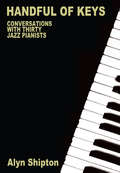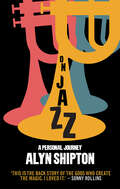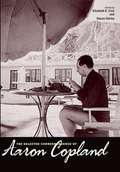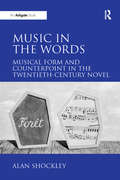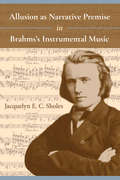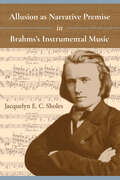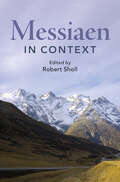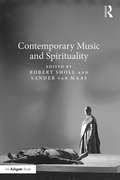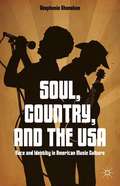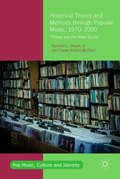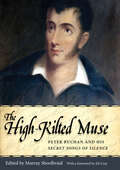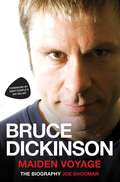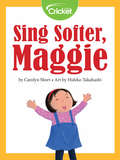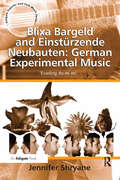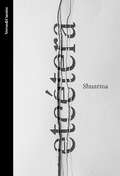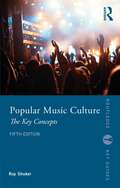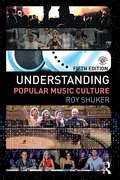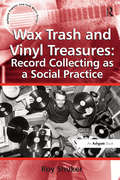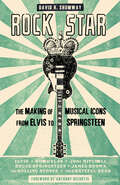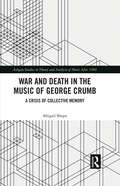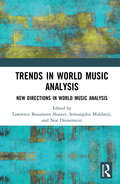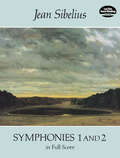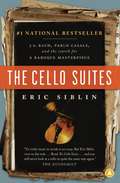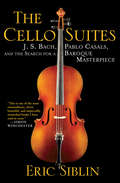- Table View
- List View
Handful of Keys: Conversations with 30 Jazz Pianists (Popular Music History Ser.)
by Alyn ShiptonFirst Published in 2005. Routledge is an imprint of Taylor & Francis, an informa company.
On Jazz: A Personal Journey
by Alyn ShiptonFew musical genres inspire the passionate devotion of jazz. Its mystique goes far beyond the melodies and rhythms, with its key players and singers discussed by aficionados with a respect that borders on reverence. Some books on jazz offer little more than theory or dry facts, thereby relinquishing the 'essence' of the music. This book is different. One of the most influential and internationally known writers on the subject describes, through vivid personal contacts, reminiscences and zesty anecdotes, his life in jazz as a player, broadcaster and observer. Alyn Shipton recalls friendships with legendary musicians, while revealing fresh discoveries about such luminaries as Fats Waller, Louis Armstrong, Count Basie, Duke Ellington, Charlie Parker, Abbey Lincoln and Geri Allen. On Jazz powerfully evokes the atmosphere of clubs and dancehalls, and takes us behind the scenes and up onto the stage, so that this electrifying world is unforgettably spotlighted as never before.
The Selected Correspondence of Aaron Copland
by Wayne Shirley Aaron Copland Elizabeth Bergman CristThis is the first book devoted to the correspondence of composer Aaron Copland, covering his life from age eight to eighty-seven. The chronologically arranged collection includes letters to many significant figures in American twentieth-century music as well as Copland's friends, family, teachers, and colleagues. Selected for readability, interest, and the light they cast upon the composer's thoughts and career, the letters are carefully annotated and each published in its entirety. Copland was a gifted and natural letter writer who revealed much more about himself in his letters than in formal writings in which he was conscious of his position as spokesman for modern music. The collected letters offer insights into his music, personality, and ideas, along with fascinating glimpses into the lives of such other well-known musicians as Leonard Bernstein, Carlos Chávez, William Schuman, and Virgil Thomson.
Music in the Words: Musical Form and Counterpoint in the Twentieth-Century Novel
by Alan ShockleyThere is a strong tradition of literary analyses of the musical artwork. Simply put, all musicology - any writing about music - is an attempt at making analogies between what happens within the world of sound and language itself. This study considers this analogy from the opposite perspective: authors attempting to structure words using musical forms and techniques. It's a viewpoint much more rarely explored, and none of the extant studies of novelists' musical techniques have been done by musicians. Can a novel follow the form of a symphony and still succeed as a novel? Can musical counterpoint be mimicked by words on a page? Alan Shockley begins looking for answers by examining music's appeal for novelists, and then explores two brief works, a prose fugue by Douglas Hofstadter, and a short story by Anthony Burgess modeled after a Mozart symphony. Analyses of three large, emblematic attempts at musical writing follow. The much debated 'Sirens' episode of James Joyce's Ulysses, which the author famously likened to a fugue, Burgess' largely ignored Napoleon Symphony: A Novel in Four Movements, patterned on Beethoven's Eroica, and Joyce's Finnegans Wake, which Shockley examines as an attempt at composing a fully musicalized language. After these three larger analyses, Shockley discusses two quite recent brief novels, William Gaddis' novella Agap gape and David Markson's This is not a novel, proposing that each of these confounding texts coheres elegantly when viewed as a musically-structured work. From the perspective of a composer, Shockley offers the reader fresh tools for approaching these dense and often daunting texts.
Allusion as Narrative Premise in Brahms’s Instrumental Music (Musical Meaning and Interpretation)
by Jacquelyn E. SholesWho inspired Johannes Brahms in his art of writing music? In this book, Jacquelyn E. C. Sholes provides a fresh look at the ways in which Brahms employed musical references to works of earlier composers in his own instrumental music. By analyzing newly identified allusions alongside previously known musical references in works such as the B-Major Piano Trio, the D-Major Serenade, the First Piano Concerto, and the Fourth Symphony, among others, Sholes demonstrates how a historical reference in one movement of a work seems to resonate meaningfully, musically, and dramatically with material in other movements in ways not previously recognized. She highlights Brahms's ability to weave such references into broad, movement-spanning narratives, arguing that these narratives served as expressive outlets for his complicated, sometimes conflicted, attitudes toward the material to which he alludes. Ultimately, Brahms's music reveals both the inspiration and the burden that established masters such as Domenico Scarlatti, J. S. Bach, Haydn, Mozart, Schubert, Schumann, Wagner, and especially Beethoven represented for him as he struggled to emerge with his own artistic voice and to define and secure his unique position in music history.
Allusion as Narrative Premise in Brahms's Instrumental Music (Musical Meaning And Interpretation Ser.)
by Jacquelyn E. SholesA musicologist offers a fresh look at how Brahms used the inspiration of earlier composers in his own instrumental works.As Jacquelyn E. C. Sholes reveals in this study, an essential aspect of Johannes Brahms’s art was the canny use of musical references to the works of others. By analyzing newly identified allusions alongside previously known musical references in works such as the B-Major Piano Trio, the D-Major Serenade, the First Piano Concerto, and the Fourth Symphony, Sholes demonstrates how a historical reference in one movement can resonate meaningfully, musically, and dramatically with material in other movements in ways not previously recognized.Brahms masterfully wove such references into broad, movement-spanning narratives. Sholes argues that these narratives served as expressive outlets for his complicated attitudes toward the material to which he alludes. Ultimately, Brahms’s music reveals both the inspiration and the burden that established masters such as Domenico Scarlatti, J. S. Bach, Haydn, Mozart, Schubert, Schumann, Wagner, and especially Beethoven represented for him as he struggled to establish his own artistic voice and place in musical history.
Messiaen in Context (Composers in Context)
by Robert ShollExploring the many dimensions of Messiaen's life, thought and music, this book provides fresh perspectives on the contexts within which the composer worked, the intellectual currents that influenced him, and the influence he himself exerted on twentieth-century music. It enables a holistic understanding of this 'mondial' French composer in relation to the wider world, including his engagement with and refiguration of theology through music, the performance and reception of his work, the ways in which his aesthetics and conceptual universe have been understood by his students, and how his legacy continues to evolve. Reappraising known facts and adding new interpretations from a variety of inter-disciplinary and multi-disciplinary viewpoints, Messiaen in Context provides a fresh understanding and engagement with one of the most significant musicians of the twentieth century.
Contemporary Music and Spirituality
by Robert Sholl Sander Van MaasThe flourishing of religious or spiritually-inspired music in the late twentieth and early twenty-first centuries remains largely unexplored. The engagement and tensions between modernism and tradition, and institutionalized religion and spirituality are inherent issues for many composers who have sought to invoke spirituality and Otherness through contemporary music. Contemporary Music and Spirituality provides a detailed exploration of the recent and current state of contemporary spiritual music in its religious, musical, cultural and conceptual-philosophical aspects. At the heart of the book are issues that consider the role of secularization, the claims of modernity concerning the status of art, and subjective responses such as faith and experience. The contributors provide a new critical lens through which it is possible to see the music and thought of Cage, Ligeti, Messiaen, Stockhausen as spiritual music. The book surrounds these composers with studies of and by other composers directly associated with the idea of spiritual music (Harvey, Gubaidulina, MacMillan, Pärt, Pott, and Tavener), and others (Adams, Birtwistle, Ton de Leeuw, Ferneyhough, Ustvolskaya, and Vivier) who have created original engagements with the idea of spirituality. Contemporary Music and Spirituality is essential reading for humanities scholars and students working in the areas of musicology, music theory, theology, religious studies, philosophy of culture, and the history of twentieth-century culture.
Soul, Country, and the USA
by Stephanie ShonekanIn twenty-first century America, soul music and country music hold influential positions as the two central flagships that propel the expression and evolution of American popular culture. From their respective but concentric positions on opposite ends of the perpetual continuum of American racial identity, these musical cultures attract their audiences with their distinctive musical aesthetics and characteristically relatable cultural messages. Applying ethnomusicological tools, this book examines the socio-cultural influences and consequences of these two genres: the perception of and resistance to hegemonic structures from within their respective constituencies, the definition of national identity, and the understanding of the "American Dream. " These genres communicate coded information to their enthusiasts whose experiences and world views are formed and reinforced in this transaction between producers and consumers. Each emerging American reality revolves around a unique sub-culture that is replete with its own highly developed signifiers and undergirded by its own interpretation of identity, space, vernacular, and politics. In the midst of these divergent realities, these two musical cultures are direct descendants of a common ancestor. The southern Americana musical tradition, which emerged from the experience of poverty and working class struggle, serves as the cultural and aesthetic progenitor from which these genres and their associated cultural mores have derived.
Historical Theory and Methods through Popular Music, 1970–2000
by Kenneth L. Shonk Jr. Daniel Robert McclureThis book examines the post-1960s era of popular music in the Anglo-Black Atlantic through the prism of historical theory and methods. By using a series of case studies, this book mobilizes historical theory and methods to underline different expressions of alternative music functioning within a mainstream musical industry. Each chapter highlights a particular theory or method while simultaneously weaving it through a genre of music expressing a notion of alternativity--an explicit positioning of one's expression outside and counter to the mainstream. Historical Theory and Methods through Popular Music seeks to fill a gap in current scholarship by offering a collection written specifically for the pedagogical and theoretical needs of those interested in the topic.
The High-Kilted Muse: Peter Buchan and His Secret Songs of Silence
by Murray ShoolbraidIn 1832 the Scottish ballad collector Peter Buchan of Peterhead, Aberdeenshire, presented an anthology of risqué‚ and convivial songs and ballads to a Highland laird. When Professor Francis James Child of Harvard was preparing his magisterial edition of The English and Scottish Popular Ballads, he made inquiries about it, but it was not made available in time to be considered for his work. On his death it was presented to the Child Memorial Library at Harvard. Because of its unseemly materials, the manuscript languished there since, unprinted, though referred to now and again, and a few items from time to time made an appearance. The manuscript has now been transcribed with full annotation and with an introduction on the compiler, his times, and the Scottish bawdy tradition. It contains the texts (without tunes) of seventy-six bawdy songs and ballads, along with a long-lost scatological poem attributed to the Edinburgh writer James “Balloon” Tytler. Appendices give details of Buchan's two published collections of ballads. Additionally, there is a list of tale types and motifs, a glossary of Scots and archaic words, a bibliography, and an index. The High-Kilted Muse brings to light a long-suppressed volume and fills in a great gap in published bawdy songs and ballads.
Bruce Dickinson: Maiden Voyage: The Biography
by Joe Shooman<p>Bruce Dickinson is the mighty voice behind legendary heavy metal behemoths Iron Maiden, and many more things besides. Prior to joining Maiden in 1981 for their seminal, multi-million selling Number of the Beast--one of the most influential records in the history of Heavy Metal--Dickinson enjoyed stardom with fellow New Wave Of British Heavy Metal artists Samson, while his post-Maiden solo career also brought much critical success. <p>Not content to merely continue shaping the face of metal music, Dickinson is a true renaissance man: a world-class member of the British Fencing team; a fiction author; a military historian; a TV presenter; and also a first officer for commercial airline Astreus. <p>Yet in 2015, the voice, and the life, of Iron Maiden's singer were placed in jeopardy as he was diagnosed with a golf-ball sized cancerous tumor on his tongue. But after making a full recovery, Iron Maiden have released an acclaimed 16th album, The Book of Souls, and announced a world tour, and Bruce stands astride the pantheon of metal greats once more. <p>This first biography of Bruce Dickinson tells his story through exclusive interviews with those who know him best.
Sing Softer, Maggie
by Carolyn ShortMaggie loves to sing, but her mother keeps telling her to sing more softly.
Blixa Bargeld and Einstürzende Neubauten: 'Evading do-re-mi' (Ashgate Popular and Folk Music Series)
by Jennifer ShryaneAt the end of his life, Pierre Schaeffer commented that his musical and sound experiments had attempted to go beyond 'do-re-mi'. This had a direct bearing on Einstürzende Neubauten's musical philosophy and work, with the musicians always striving to extend the boundaries of music in sound, instrumentation and purpose. The group are one of the few examples of 'rock-based' artists who have been able to sustain a breadth and depth of work in a variety of media over a number of years while remaining experimental and open to development. Jennifer Shryane provides a much-needed analysis of the group's important place in popular/experimental music history. She illustrates their innovations with found- and self-constructed instrumentation, their Artaudian performance strategies and textual concerns, as well as their methods of independence. Einstürzende Neubauten have also made a consistent and unique contribution to the development of the independent German Language Contemporary Music scene, which although often acknowledged as influential, is still rarely examined.
Etcétera
by ShuarmaEl primer poemario de Shuarma, artista, vocalista de Elefantes y uno de los compositores más populares del panorama pop nacional. «Los textos que componen este libro persiguen la voluntad de alejarte de la realidad, llevarte a otro lugar y sugerirte nuevas visiones, no las mías, sino las que te surjan a ti a través de mis propuestas. Yo enciendo la mecha y tu explotas. Aunque a decir verdad eres tú quien enciende la mecha al decidirte a leer. Siempre comienzas tú». El error es un maestro; crear, la libertad más absoluta. De la magia de lo incompleto, de la sabiduría que se esconde tras la duda y del juego del arte habla este libro. En él, Shuarma -músico, vocalista del célebre grupo Elefantes y artista multidisciplinar- recoge textos que van de lo íntimo a lo lúdico y lo surrealista, que permanecen abiertos a la interpretación, a la espera de que el lector los experimente de una manera única y particular. Una reflexión sobre el poder de la creación y una reivindicación de la misma como acto universal.
Popular Music Culture: The Key Concepts (Routledge Key Guides)
by Roy ShukerNow in its fifth edition, this popular A–Z student reference book provides a comprehensive survey of key ideas and concepts in popular music culture, examining the social and cultural aspects of popular music. Fully revised with extended coverage of the music industries, sociological concepts and additional references to reading, listening and viewing throughout, the new edition expands on the foundations of popular music culture, tracing the impact of digital technology and changes in the way in which music is created, manufactured, marketed and consumed. The concept of metagenres remains a central part of the book: these are historically, socially, and geographically situated umbrella musical categories, each embracing a wide range of associated genres and subgenres. New or expanded entries include: Charts, Digital music culture, Country music, Education, Ethnicity, Race, Gender, Grime, Heritage, History, Indie, Synth pop, Policy, Punk rock and Streaming. Popular Music Culture: The Key Concepts is an essential reference tool for students studying the social and cultural dimensions of popular music.
Understanding Popular Music Culture
by Roy ShukerThis extensively revised and expanded fifth edition of Understanding Popular Music Culture provides an accessible and comprehensive introduction to the production, distribution, consumption and meaning of popular music, and the debates that surround popular culture and popular music. Reflecting the continued proliferation of popular music studies, the new music industry in a digital age, and the emergence of new stars, this new edition has been reorganized and extensively updated throughout, making for a more coherent and sequenced coverage of the field. These updates include: two new chapters entitled 'The Real Thing': Authenticity, covers and the canon and 'Time Will Pass You By': Histories and popular memory new case studies on artists including The Rolling Stones, Lorde, One Direction and Taylor Swift further examples of musical texts, genres, and performers throughout including additional coverage of Electronic Dance Music expanded coverage on the importance of the back catalogue and the box set; reality television and the music biopic greater attention to the role and impact of the internet and digital developments in relation to production, dissemination, mediation and consumption; including the role of social network sites and streaming services each chapter now has its own set of expanded references to facilitate further investigation. Additional resources for students and teachers can also be found on the companion website (www.routledge.com/cw/shuker), which includes additional case studies, links to relevant websites and a discography of popular music metagenres.
Wax Trash and Vinyl Treasures: Record Collecting As A Social Practice (Ashgate Popular And Folk Music Ser.)
by Roy ShukerThe term 'record collecting' is shorthand for a variety of related practices. Foremost is the collection of sound recordings in various formats - although often with a marked preference for vinyl - by individuals, and it is this dimension of record collecting that is the focus of this book. Record collecting, and the public stereotypes associated with it, is frequently linked primarily with rock and pop music. Roy Shuker focuses on these broad styles, but also includes other genres and their collectors, notably jazz, blues, exotica and 'ethnic' music. Accordingly, the study examines the history of record collecting; profiles collectors and the collecting process; considers categories - especially music genres - and types of record collecting and outlines and discusses the infrastructure within which collecting operates. Shuker situates this discussion within the broader literature on collecting, along with issues of cultural consumption, social identity and 'the construction of self' in contemporary society. Record collecting is both fascinating in its own right, and provides insights into broader issues of nostalgia, consumption and material culture.
The Inner Light: How India Influenced the Beatles
by Susan ShumskyThe hidden meanings of the Beatles&’ most esoteric lyrics and sounds are revealed by a rare insider who spent two decades with the man who made &“meditation,&” &“mantra,&” and &“yoga&” household words: Maharishi Mahesh Yogi. &“I absolutely love this book. Between the stories and the pictures, many I&’ve not seen before, this is truly a spiritual journey.&” —Chris O&’Dell, author of Miss O&’Dell, My Hard Days and Long Nights with The Beatles, The Stones, Bob Dylan, and the Women They LovedThe spiritual journey of the Beatles is the story of an entire generation of visionaries in the sixties who transformed the world. The Beatles turned Western culture upside down and brought Indian philosophy to the West more effectively than any guru. The Inner Light illumines hidden meanings of the Beatles&’ India-influenced lyrics and sounds, decoded by Susan Shumsky—a rare insider who spent two decades in the ashrams and six years on the personal staff of the Beatles&’ mentor, Maharishi Mahesh Yogi. &“With clarity, depth, and impeccable research, an exceptionally comprehensive book filled with engaging tales and fresh insights that even diehard Beatles fans will find illuminating.&” —Philip Goldberg, author of American Veda: From Emerson and The Beatles to Yoga and Meditation, How Indian Spirituality Changed the West This eye-opening book draws back the curtain on the Beatles&’ experiments with psychedelics, meditation, chanting, and Indian music. Among many shocking revelations never before revealed, we discover who invented "raga rock" (not the Beatles), the real identity of rare Indian instruements and musicians on their tracks, which Beatle was the best meditator (not George), why the Beatles left India in a huff, John and George&’s attempts to return, Maharishi&’s accurate prediction, and who Sexy Sadie, Jojo, Bungalow Bill, Dear Prudence, Blackbird, My Sweet Lord, Hare Krishna, and the Fool on the Hill really were. &“This book reminds us in illuminating fashion why Susan is the premier thinker about India&’s key influence upon the direction of the Beatles&’ art. In vivid and stirring detail, she traces the Fabs&’ spiritual awakening from Bangor to Rishikesh and beyond.&” —Kenneth Womack, author of John Lennon 1980: The Last Days in the Life Half a century later, the Beatles have sold more records than any other recording artist. A new generation wants to relive the magic of the flower-power era and is now discovering the message of this iconic band and its four superstars. For people of all nations and ages, the Beatles&’ mystique lives on. The Inner Light is Susan Shumsky&’s gift to their legacy.
Rock Star: The Making of Musical Icons from Elvis to Springsteen
by David R. ShumwayThe nature and meaning of rock stardom—celebrities who embody the most important social and cultural conflicts of their era."All stars are celebrities, but not all celebrities are stars," states David Shumway in the introduction to Rock Star, an informal history of rock stardom. This deceptively simple statement belies the complex definition and meaning of stardom and more specifically of rock icons. Shumway looks at the careers and cultural legacies of seven rock stars in the context of popular music and culture—Elvis Presley, James Brown, Bob Dylan, the Rolling Stones, the Grateful Dead, Joni Mitchell, and Bruce Springsteen. Granted, there are many more names that fall into the rock icon category and that might rightfully appear on this list. Partly, that is the point: "rock star" is a familiar and desired category but also a contested one.Shumway investigates the rock star as a particular kind of cultural construction, different from mere celebrity. After the golden age of moviemaking, media exposure allowed rock stars more political sway than Hollywood's studio stars, and rock stars gradually replaced movie stars as key cultural heroes. Because of changes in American society and the media industries, rock stars have become much more explicitly political figures than were the stars of Hollywood’s studio era. Rock stars, moreover, are icons of change, though not always progressive, whose public personas read like texts produced collaboratively by the performers themselves, their managers, and record companies. These stars thrive in a variety of media, including recorded music, concert performance, dress, staging, cover art, films, television, video, print, and others.Filled with memorable photographs, Rock Star will appeal to anyone interested in modern American popular culture or music history.
War and Death in the Music of George Crumb: A Crisis of Collective Memory (Ashgate Studies in Theory and Analysis of Music After 1900)
by Abigail ShupeThis book studies George Crumb’s The Winds of Destiny (2004) and Black Angels (1970) as artifacts of collective memory and cultural trauma. It situates these two pieces in Crumb’s output and unpacks the complex methodologies needed to understand these pieces as contributions and challenges to traditional narratives of the Civil War and the Vietnam War. The Winds of Destiny is shown to be a critical commentary on the legacy of American wars and militarism, both concepts crucial to American identity. The Winds of Destiny also acts as an ironic war memorial as a means of critiquing such concepts. Black Angels has long been associated with the Vietnam War. This book shows how this association began and how it endures through connections to iconic Vietnam War media, including films and books. Together these analyses show the legacy of trauma in American collective memory, which is in a continuous crisis. Crumb’s musical critiques point to a need to resist conventional narratives and to begin to heal trauma on a collective level. This book will be of interest to students of contemporary American music, American studies, and memory studies. It benefits readers by newly situating Crumb’s music within these three fields of study.
Trends in World Music Analysis: New Directions in World Music Analysis
by Lawrence Beaumont ShusterThis volume brings together a group of analytical chapters exploring traditional genres and styles of world music, capturing a vibrant and expanding field of research. These contributors, drawn from the forefront of researchers in world music analysis, seek to break down barriers and build bridges between scholarly disciplines, musical repertoires, and cultural traditions. Covering a wide range of genres, styles, and performers, the chapters bring to bear a variety of methodologies, including indigenous theoretical perspectives, Western music theory, and interdisciplinary techniques rooted in the cognitive and computational sciences. With contributors addressing music traditions from Africa, Asia, Europe, and the Americas, this volume captures the many current directions in the analysis of world music, offering a state of the fi eld and demonstrating the expansion of possibilities created by this area of research.
Symphonies 1 and 2: In Full Score
by Jean SibeliusFinland's greatest composer and a major figure in the development of Scandinavian music, Jean Sibelius (1865-1957) is admired for his complete mastery of symphonic form. Of the seven symphonies he composed, each differs greatly from the others, for Sibelius rarely approached the symphonic "problem" the same way. Each work seems committed to the thoughts, feelings, and logic of the movement.Sibelius's first two symphonies remain among his most accessible and popular. Of all his symphonic works, perhaps the First Symphony, composed in 1898-99, adheres most to classical form yet reflects the spirit of Nordic nationalism that came to be associated with the composer's music.The Second Symphony, perhaps his most expansive and melodious work in symphonic form, demonstrates Sibelius's increasing command of orchestral form and scoring. These two major works are reprinted here from the definitive full-score editions published by Breitkopf & Härtel, Leipzig.
The Cello Suites: J. S. Bach, Pablo Casals, and the Search for a Baroque Masterpiece
by Eric SiblinOne autumn evening, shortly after ending a ten-year stint as a pop-music columnist for the Montreal Gazette, Eric Siblin attended a concert at Toronto's Royal Conservatory of Music. There, something unlikely happened: he fell in love with a piece of classical music -- Bach's cello suites. Part biography, part music history, and part literary mystery, The Cello Suites weaves together three dramatic stories: The first features Johann Sebastian Bach and the missing manuscript of his suites from the eighteenth century; the second is that of Pablo Casals and his incredible discovery of the manuscript in Spain in the early twentieth century; and the third is Eric Siblin's own infatuation with the suites in the twenty-first century. This love affair leads Siblin to the back streets of Barcelona, a Belgian mansion, and a bombed out German palace; to interviews with cellists Mischa Maisky, Anner Bylsma, and Pieter Wispelwey; to archives, festivals, conferences, and cemeteries; and even to cello lessons -- all in pursuit of answers to the mysteries that continue to haunt this piece of music more than 250 years after its composer's death. The Cello Suites is an incomparable, beautifully written, true-life journey of passion, imagination, and discovery, fuelled by the transcendent power of a musical masterpiece.
The Cello Suites: J. S. Bach, Pablo Casals, and the Search for a Baroque Masterpiece
by Eric SiblinOne evening, journalist Eric Siblin attended a recital of Johann Sebastian Bach's Cello Suites and began an epic quest that would unravel three centuries of intrigue, politics, and passion. Winner of the Mavis Gallant Prize for Nonfiction and the McAuslan First Book Prize, The Cello Suites weaves together three dramatic narratives: the disappearance of Bach's manuscript in the eighteenth century; Pablo Casals's discovery and popularization of the music in Spain in the late-nineteenth century; and Siblin's infatuation with the suites in the present day. The search led Siblin to Barcelona, where Casals, just thirteen and in possession of his first cello, roamed the backstreets with his father in search of sheet music and found Bach's lost suites tucked in a dark corner of a store. Casals played them every day for twelve years before finally performing them in public. Siblin pursues the mysteries that continue to haunt this music more than 250 years after its composer's death: Why did Bach compose the suites for the cello, then considered a lowly instrument? What happened to the original manuscript? A seamless blend of biography and music history, The Cello Suites is a true-life journey of discovery, fueled by the power of these musical masterpieces.
